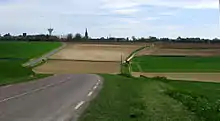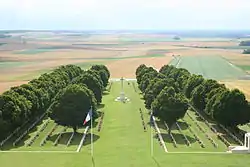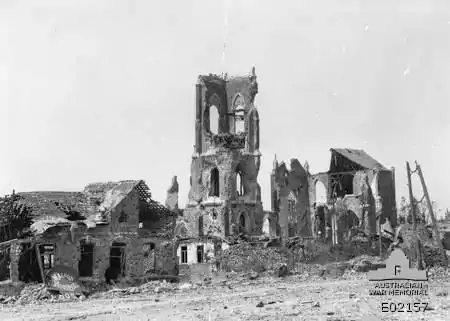Villers-Bretonneux
Villers-Bretonneux is a commune in the Somme department in Hauts-de-France in northern France.
Villers-Bretonneux | |
|---|---|
 Villers-Bretonneux Town Hall | |
 Coat of arms | |
Location of Villers-Bretonneux 
| |
 Villers-Bretonneux  Villers-Bretonneux | |
| Coordinates: 49°52′N 2°31′E | |
| Country | France |
| Region | Hauts-de-France |
| Department | Somme |
| Arrondissement | Amiens |
| Canton | Amiens-4 |
| Intercommunality | Val de Somme |
| Government | |
| • Mayor (2008–2014) | Patrick Simon |
| Area 1 | 14.51 km2 (5.60 sq mi) |
| Population (2017-01-01)[1] | 4,464 |
| • Density | 310/km2 (800/sq mi) |
| Time zone | UTC+01:00 (CET) |
| • Summer (DST) | UTC+02:00 (CEST) |
| INSEE/Postal code | 80799 /80800 |
| Elevation | 45–107 m (148–351 ft) (avg. 91 m or 299 ft) |
| 1 French Land Register data, which excludes lakes, ponds, glaciers > 1 km2 (0.386 sq mi or 247 acres) and river estuaries. | |
Geography

Villers-Bretonneux is situated some 19 km due east of Amiens, on the D1029 road and the A29 motorway.
Villers-Bretonneux borders a particularly orange landscape towards the east, which can be considered as the western boundary of the Santerre plateau and the limit East of the Amiénois.
The territory of the commune is crossed by the old national road 29 (current RD 1029), perfectly rectilinear road following the route of the ancient Roman road linking Amiens to Saint-Quentin in the Aisne. The agglomeration is located at the crossroads of the D 23 linking Corbie to Moreuil.
Villers-Bretonneux is located on the railway line from Amiens to Laon via Tergnier.
History
Prehistoric era
Polished flints from the neolithic era indicate that a human presence has been in the commune for a long time.
Antiquity
Roman coins, remains of dwelling and a sandstone mill from during the Roman Empire have been found near the town, which was on the old way linking Amiens to Vermand.[2]
Middle Ages
In 1840, archaeological excavations revealed stone coffins, vases and buckles dating from the Frankish period.
The first mention of the name Villers-Bretonneux is in a document from 1123.[2] It was not until the 12th century that the Bretoneux or Bretonneux complement was added; prior to this the town was known as Villers. The origin of this change has historians perplexed.[3] In 1200, the lord of Villers-Bretonneux, Adams de Villers was vassal of the Abbot of Corbie. In the 14th century, the village was surrounded by a wall twelve feet high and counted 140 hovels. The castle was surrounded by a wall fifteen feet high. Waleran de Rivery, lord of Rivery and Villers-Bretonneux, married Isabelle, second daughter of Jacques de Longroy (councilor and chamberlain of the Duke of Burgundy), lord of Querrieu, who was killed at the Battle of Agincourt in 1415. In the second half of the 15th century, the lord was Antoine de Rivery, knight, captain of Amiens in 1465 and lord of Rivery and Villers-Bretonneux.[4][5]
17th century
On 13 August 1636, the Spanish Army set fire to the village, as well as several villages in the vicinity. It was probably during these events connected with the capture of Corbie that the fortress was destroyed. An exact date is not known but in 1681 it was mentioned as completely in ruins.[6]
18th century
In 1700, the seigniory of Villers-Bretonneux was sold to Pierre Dufresne, lord of Marcelcave.[7] As early as 1737, the wool industry was mentioned in Villers-Bretonneux.[7] In 1778, Pierre Dottin, a native of Villers-Bretonneux, published a memoir on the "la pomme de terre" in Les Affiches de la Picardie.[7]
19th century
In 1838, records show[8] that Villers-Bretonneux is one of the richest and most commercial communes in the department and that factories producing woollen stockings and flannels are well established. In 1859, the town built a church[9] that was destroyed during the First World War. It housed a wooden Virgin from the l'école de Blasset school.[10]
On 27 November 1870, Villers Bretonneux was the scene of a battle of the Franco-Prussian War (1870–1871) for the defense of Amiens. The French were defeated, and the population had to pay a tribute of 100,000 francs to the Prussians.
20th century
In the First World War the town was the site of the First Battle of Villers-Bretonneux and Second Battle of Villers-Bretonneux. The first tank against tank combat in history took place here on 24 April 1918.
.jpg.webp)
_(19269620194).jpg.webp)
 German Tank outside the town 1918
German Tank outside the town 1918 Rue de la Gare, Villers Bretonneux 1918.
Rue de la Gare, Villers Bretonneux 1918. A Crashed Fokker at Villers-Bretonneux
A Crashed Fokker at Villers-Bretonneux
In the interwar years, the city of Melbourne in Australia was a sponsor of the town of Villers-Bretonneux and helped in its reconstruction as did as the State of Victoria more generally. On 22 July 1938, the Villers–Bretonneux Australian National Memorial was opened by the British sovereigns, George VI, Elizabeth Bowes-Lyon and Albert Lebrun, President of the French Republic. The names of 11,000 fighters without burial are engraved in the stone.
In World War II the British Army had Sherman tank Armoured Division passed through Villers-Bretonneux, on 1 September 1944. There is a memorial near the town dedicated to the memory of the Forces françaises de l'intérieur, shot and deported during 1939–45, located on the road to Amiens.
Twenty-first century
Today, Villers-Bretonneux is a modest village, which grew significantly thanks to the introduction of the knitwear industry in the 19th century. After the destruction of the First and Second World Wars, the town was rebuilt. The city center concentrates public buildings and most of the dwellings.
The municipality is now experiencing a new development thanks to its proximity to the Amiens agglomeration and to an exit from the A29 motorway (Saint-Quentin-Le Havre). Subdivisions of individual houses were built.
Patrick Simon, the Mayor of Villers-Bretonneux from 2008 until 2020, was a vocal proponent of Australia-France relations.[11] Simon oversaw the refurbishment of Villers-Bretonneux's Franco-Australian First World War Museum and helped to establish the Sir John Monash Centre, which opened in 2018.[11][12] He also promoted increased relations and exchanges with Robinvale, Villers-Bretonneux's twinned town in the Australian state of Victoria.[13] Simon was awarded an honorary Order of Australia (AO) in 2015 for his contributions to Australian-Franco relations.[11][14] He died in office in May 2020 during the COVID-19 pandemic in France.[11][14][15]
Economic and services
The increase in the population of the commune was linked to the development of knitwear in the 19th century. This activity began to decline from the 1880s onwards. The decline continued after the two world wars until they disappeared completely at the dawn of the twenty-first century.
Today, it is the services that constitute most of the economic activity: shopping center near the motorway exit, retail and handicrafts in the city center. Health services are represented by the presence of a nursing home and a convalescent and functional rehabilitation center in addition to the liberal professionals. The school functions are represented by nursery and primary schools and by a college.
First World War

In the First World War, on 24 April 1918, Villers-Bretonneux was the site of the world's first battle between two tank forces: three British Mark IVs against three German A7Vs. The Germans took the town, but that night and the next day it was recaptured by two brigades of the First Australian Imperial Force at a cost of some 1,200 Australian lives.[16] The town's mayor spoke of the Australian troops on 14 July 1919 when unveiling a memorial in their honour:
The Australian War Memorial in France is located just outside Villers-Bretonneux and in front of it lie the graves of over 770 Australian soldiers, as well as those of other British Empire soldiers involved in the campaign. The school in Villers-Bretonneux was rebuilt using donations from school children of Victoria, Australia (many of whom had relatives perish in the town's liberation) and above every blackboard is the inscription, "N'oublions jamais l'Australie" (Let us never forget Australia).[18][19] The annual Anzac Day ceremony is held at this village on Anzac Day, 25 April. Traditionally, Australian commemorations have focused on Gallipoli. However, Anzac Day commemorations since 2008 have also focused on the Western Front, and dawn services marking the anniversary of the battle of 24/25 April 1918 are held on Anzac Day itself at Villers-Bretonneux.[20][21]
Villers-Bretonneux is the sister city of Robinvale, Victoria, Australia.[22]
Population
In 2017, the commune had 4,464 inhabitants, an increase of 8.5% compared to 2007.
|
| ||||||||||||||||||||||||||||||||||||||||||||||||||||||||||||||||||||||||||||||||||||||||||||||||||||||||||||||||||
| Source: EHESS[23] and INSEE (1968-2017)[24] | |||||||||||||||||||||||||||||||||||||||||||||||||||||||||||||||||||||||||||||||||||||||||||||||||||||||||||||||||||
Places of interest
Delacour's château, or, as the Australian force called it, the "Red château", served as headquarters and billets for Allied generals during the Battle of the Somme. Marshal Foch stayed there. At the end of fighting in November 1918 it became the local headquarters of the Imperial (later Commonwealth) Graves Commission. Later abandoned, it was extensively cannibalised for building materials. Its skeleton, which remained as a tourist attraction until 2004, was razed in that year and all traces of it were removed to make way for a supermarket.
See also
References
- "Populations légales 2017". INSEE. Retrieved 6 January 2020.
- Notice géographique et historique sur la commune de Villers-Bretonneux, rédigée par M. Corbin, instituteur, 1899, Archives départementales de la Somme
- Hector Josse " Dictionnaire historique et archéologique de la Picardie ", Vol.II, Cantons de Corbie, page 95 (1912, reprint Éditions Culture et Civilisation, Bruxelles, 1979)
- L. Ledieu – " Dictionnaire historique et archéologique de la Picardie ", Tome I, Cantons d'Amiens, page 158 (1909, reprint Éditions Culture et Civilisation, Bruxelles, 1979)
- G. de Witasse et L. Ledieu – " Dictionnaire historique et archéologique de la Picardie ", volI, Canton de Conty, pages 352–353 (1909, reprint Éditions Culture et Civilisation, Bruxelles, 1979).
- Hector Josse, Dictionnaire historique et archéologique de la Picardie, tome II, Cantons de Corbie, page 97 (1912, reprint Éditions Culture et Civilisation, Bruxelles, 1979)
- Notice géographique et historique sur la commune de Villers-Bretonneux, rédigée par M. Corbin, instituteur, 1899, Archives départementales de la Somme.
- Guide pittoresque du voyageur en France, in " La Somme ", éd. du Bastion, reprint 1994 – page 40
- villages / Villers-Bretonneux" du site perso de Marie-France et Jean-Pierre Gourdain.
- Hector Josse, Dictionnaire historique et archéologique de la Picardie, tome II, Cantons de Corbie, page 99 (1912, reprint Éditions Culture et Civilisation, Bruxelles, 1979).
- Shields, Bevan (14 May 2020). "Australia's best friend in France dies from coronavirus". Sydney Morning Herald. Retrieved 27 July 2020.
- "Tribute to Villers-Bretonneux mayor Patrick Simon". France.fr. 6 July 2020. Archived from the original on 28 July 2020. Retrieved 28 July 2020.
- Testa, Christopher (14 May 2020). "Villers-Bretonneux mayor Patrick Simon remembered by rural Victorian town". Australian Broadcasting Corporation. Retrieved 27 July 2020.
- "Le maire de Villers-Bretonneux Patrick Simon est décédé du Covid-19". Le Courrier Picard. 13 May 2020. Archived from the original on 7 June 2020. Retrieved 27 July 2020.
- Lamarre, Vanessa (13 May 2020). "Coronavirus : décès de Patrick Simon maire de Villers-Bretonneux dans la Somme". France Bleu. Archived from the original on 7 June 2020. Retrieved 27 July 2020.
- Anzac Day: Australians flock to Villers-Bretonneux to remember diggers who died on Western Front. ABC News Perth, 25 April 2015
- "Villers-Bretonneux and Australia- Two in France". Two in France. Retrieved 17 October 2015.
- N'oublions jamais l'Australie, ("Let us never forget Australia"). Australian War Memorial, Canberra.
- The Western Front, Overview of WWI history, anzacday.org.au
- ANZAC Day focus turns to Western Front, The Sydney Morning Herald, 19 April 2008.
- Looking back on the battle of Villers-Bretonneux. ABC News Perth, 6 June 2014]
- Official Villers-Bretonneux web site
- Données Cassini, EHESS
- Population en historique depuis 1968, INSEE
Image gallery
 Australian War Memorial Cemetery in Villers-Bretonneux July 2008 – the graves of over 770 Australians, as well as those of other Commonwealth soldiers, lie here.
Australian War Memorial Cemetery in Villers-Bretonneux July 2008 – the graves of over 770 Australians, as well as those of other Commonwealth soldiers, lie here. April 2012 AWM Cemetery following removal of trees.
April 2012 AWM Cemetery following removal of trees. A German tank captured during the First World War
A German tank captured during the First World War Ruins of the church after the second battle of Villers-Bretonneux in 1918
Ruins of the church after the second battle of Villers-Bretonneux in 1918.jpg.webp) Anzac Day service, 2008
Anzac Day service, 2008
External links
| Wikimedia Commons has media related to Villers-Bretonneux. |
- Culture Victoria – historical images of the rebuilding of the Villers-Bretonneux School
- Villers-Bretonneux, Australian National Memorial
- Musée Franco-Australien de Villers-Bretonneux
